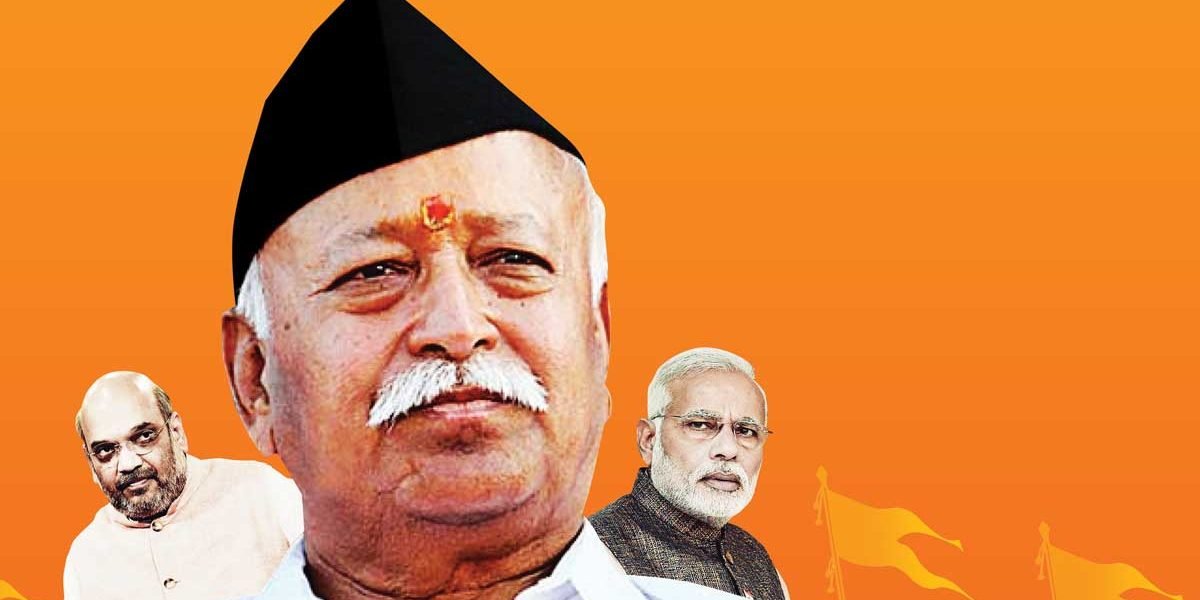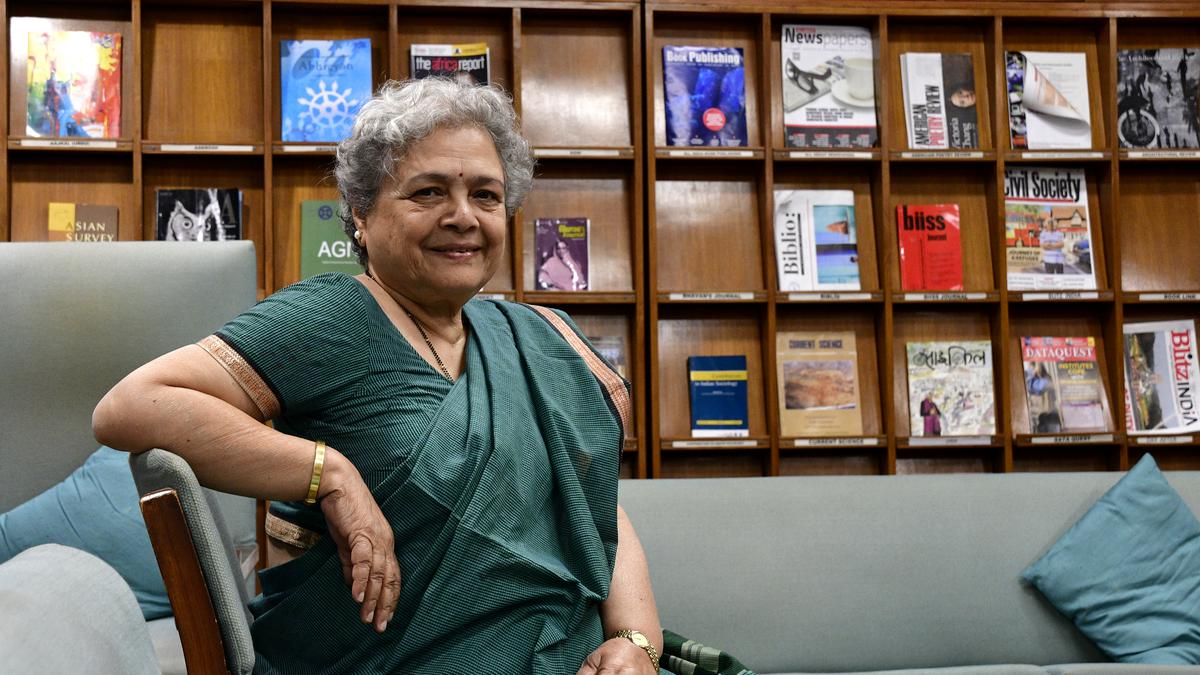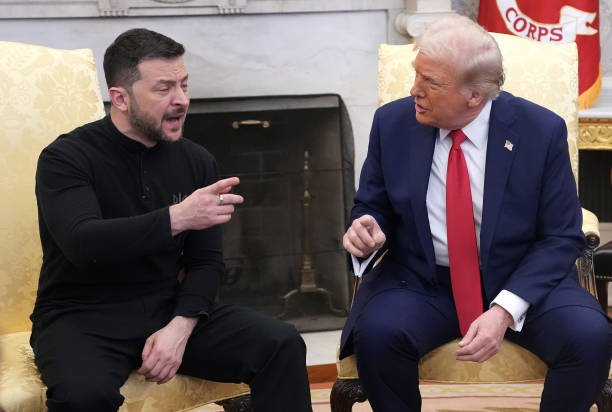Why Did the Guru Speak So Late?
 From left to right: BJP president Amit Shah, RSS chief Mohan Bhagwat, Prime Minister Narendra Modi. Illustration credit: parliamentarian.in
From left to right: BJP president Amit Shah, RSS chief Mohan Bhagwat, Prime Minister Narendra Modi. Illustration credit: parliamentarian.in
(This article is taken from The Wire)
Back home after a month abroad, one finds something within the country’s soul has changed. The new government is the old government, the new leader the old leader once again, but something has changed despite a popular pink daily reporting that, “Modi 3.0 kicks off on continuity note”.
One notices that the PMO logo has a different picture, and PM Modi refers to his PMO as ‘people’s PMO’. During the swearing-in, he can be seen hugging his yesteryear-rivals-turned colleagues and appearing in group photographs in simple white clothes jackets of soft hues. Could this be because the BJP – that he led from the front, announcing that each vote for his men would be a vote for him – failed to cross the expected number of 400? This has led to several new alliance partners with a handful of seats in the new parliament being inducted and placated with plum portfolios.
Modi has publically declared himself a humble servant, underscoring his great reverence for India’s constitution, even though during the electoral campaign, members of his party asserted that once they go Char Sau Paar, they would rewrite the constitution. It proved to be an ill-advised move like ignoring the farmers’ demands and Manipur fires for long. These provided ample ammunition to the Opposition INDI Alliance for declaring in rally after rally that the National Democratic Alliance (NDA) had a nefarious design to promote majoritarianism and do away with the reservations should they be voted back to power.

Illustration: Pariplab Chakraborty
The friendly legacy media that had promoted NDA’s campaigns with fervour, bordering on veneration, has obligingly reported now on how the first file signed by PM Modi 3:0 permitted a large grant towards PM-KISAN Yojna. The Kisans – who were berated, ignored and barred from entering Delhi when they marched from Western UP, Haryana and Punjab, demanding fulfilment of earlier promises and fair prices for their produce – are suddenly a top priority.
But six days after the results were declared, the honourable Sar Sangh Chalak, Rashtriya Swayamsevak Sangh (RSS) chief Mohan Bhagwat, who rarely analyses political matters in public, spoke scathingly about the disappointing electoral performance of the BJP at a gathering of RSS trainees at Hedgewar Smriti Bhawan in Nagpur. Though delivered in his characteristic calm tones, the speech had a vivid streak of anger running through. He rebuked the visible hubris (Ahankar) of the leadership as contrary to the Sangh’s idea of political leaders trained by it remaining humble humble servants (Sevak) of the public both in words and in action.
Ahankar, he felt, distances rulers from the ruled thus creating a deepening of rifts in society, increasing sectarian tensions. We need a mature non-confrontational relationship with the Opposition was the next Sandesh (message). All crucial national issues must be sorted out not unilaterally, but through building a consensus for the greater public good. The Pater familias of the Sangh Parivar, of which the political party is but one branch, also added bluntly that there is a need to get over political rhetoric and take cognisance of long-neglected issues like the undoused ethnic fires still burning in Manipur. Elections, Bhagwat said, without naming anyone are not wars but a political exercise to gain majority. Bad language that breaks norms of decency (Maryada) cannot be condoned, nor the dragging of the RSS in this distasteful political melee.
Our general public fed up with fake news, lies and half-truths no longer listens to the legacy media where panels and trolls are busy publically washing the electoral linen of parties. It vastly looks forward to what the independent social media is reporting and the flavour of the month was not politics but the Indo-Pak cricket wars being fought in the US.
But old hands sat up! Was the Sangh distancing itself from its precocious progeny? If so, who should they treat and report as the Man of the Match? The panicky news traffic jams it caused for the Godi media awaiting orders from the usual quarters. Most anchors and reporters by now bother little about historical contexts and remember days when issues used to be debated long and loud in the parliament, cartoonists freely lampooned powerful politicians and editors wrote hard-hitting signed editorials against policymakers. When electoral speeches were witty and did not use ugly innuendoes and despicable personal quips about leaders, minorities and women in the Opposition.
But in this confusion, it was clear who the Sar Sangh Chalak spoke of in public without mincing the words. So, the media cannot be sure any longer about the fabled respectful relationship between the RSS’s Raj Guru figure with the army generals of the BJP and its media cells.
There are times when leadership needs to think a little less about using language, a personal style of dressing and recreating imagined scenes from what is largely our mythical past until ‘they’ rode in from the cold and messed it up. A decade ago when used first it may have been electorally beneficial to dwell on the Treta Yug and Dwapar Yug, raising temples to replace not just razed ancient monuments. But also erasing parts of India’s freedom struggle to selectively erase the contribution of men like Nehru, Gandhi and Maulana Azad has proved to be counterproductive. It helped the rivals change the narrative to current issues like rampant unemployment, inflation, decaying educational institutions and increasing crimes against women and Dalits. This resonates with the young from rural areas and small towns who are deeply concerned about their futures.
We have all been witness to Modi ji’s gradual evolution from an army general to first an ascetic and then a Raj Guru presiding over religiopolitical rituals surrounded by the symbols of state, like Vedeh Raja Janak. The evolving images have been appearing and disappearing and reappearing with changes and have hung over India’s media and public spaces like Banquo’s ghost. Guru in India has always had a holy ring accompanied by a grand presence. Initially, it was the Sangh that chiselled it using the Brahminical version of Hindutva to create a figure that can act as Vasishtha-like Guru counsellor for the leader of a (so far) secular state. The Sar Sangh Chalak was seen to be such a one and it was his saffron flag that was unfurled at the Sangh Mukhyalaya in Nagpur before its devoted followers. Golwarkar, the second RSS leader, is still referred to as Guruji by the entire Sangh Parivar including its political wing.
But of late on several occasions, the gradual shift to remediating the old Guru image partially to the state has authorised state heads to directly intervene despite voluble protests from several civic bodies about the move. An example of this is the Haryana government renaming Gurgaon as Gurugram to celebrate the Mahabharata Guru of archery, Dronacharya with a questionable record for disfavouring low-caste students. Another move renaming of several streets and towns after Hindutva icons was similarly carried out despite public protests. So it was unsurprising that over time some of India’s top corporate, film stars, cricketers, corporates, media owners and media practitioners touched the new emergent Raj Guru’s feet, and bowed to photos of his predecessor Gurus.
Could this aberration be the reason why the relationship of the political party with its prime and revered moral spiritual mentor seems soured? And after the 2024 election debacle in the party’s numbers in the parliament, the Guru chose to chastise the errant acolyte from Nagpur. This speech was further followed by a rather harsh editorial in Sangh’s party journal, The Organiser. It similarly blames the poor showing of the party for not listening to the voices from the ground and picking up unsuitable candidates.
But if the Sangh actually foresaw this why was course correction not done when mistakes were being made? Was the six-day wait a deliberate ruse to denounce and voice chastise those who would not listen to the Guru?
It is notable that a few days prior to this, the BJP party president J.P. Nadda had boasted in an interview of how the party was now fully capable of handling its affairs. Thank you. Could it be that the penny now dropped for the shrewd seniors manning the Sangh gates and analysing Modi’s gradual growth from an aggressively macho general in 2014 to his self-branding (post 2019 and Covid) as a Raja and a Guru in one with total command over semiotic registers, the Party, various instruments of state and the media? Was there a thinking coming that a Rajguru could replace Hindutva with Moditva to create a new brawny Sangathan which would be all about a divine vision for India for the next millennium?
Bhagwat’s words were softly spoken, but the real sadness and pain were visible even to lay watchers. Listening to him, the wise words of the Persian king Cyrus to the Greek king Croesus came to mind: “The first thing you should appreciate is that human affairs are on a wheel and that as the wheel turns around it does not always permit the same folk to prosper.”
Mrinal Pande is a writer and veteran journalist.




Leave Comment